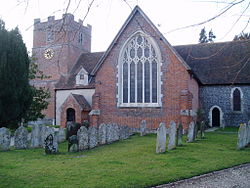Bramley, Hampshire
| Bramley | |
| Hampshire | |
|---|---|
 St. James' Church, Bramley | |
| Location | |
| Grid reference: | SU655593 |
| Location: | 51°19’44"N, 1°3’41"W |
| Data | |
| Population: | 5,875 (2011) |
| Post town: | Tadley |
| Postcode: | RG26 |
| Dialling code: | 01256 |
| Local Government | |
| Council: | Basingstoke and Deane |
| Parliamentary constituency: |
North East Hampshire |
Bramley is a village in Hampshire, a sizable place which at the 2001 had a recorded population of 3,348.
The village has a village shop, bakery, estate agency, a pub, The Bramley Inn (opened in 1897 as The Six Bells), and a railway station.
Nearby is Bramley Camp, an Army facility where military training and manoeuvres take place.
Parish church
The Church of St James stands at the west of the village and originally dates from 1160, however it features many historical alterations and additions up to the 20th Century. It is a Grade I listed building.
The physicist Lise Meitner is buried in the burial ground next to the church, near the grave of her brother Walter.
History
At Bullsdown Camp close by are the traces of a prehistoric settlement, where remnants of flint-scrapers, a spear-head, a core and flint-flakes have been found. This is thought to be a late Iron Age "triple-walled dun".This fortification can still be seen today, situated to the east of the village south of the Bramley to Sherfield road.
Bramley is on the course of a Roman road, the Chichester to Silchester Way between the Roman towns at Calleva Atrebatum (Silchester) and Chichester. The remains of a Romano-British villa have been found near Bramley.
The Reverend Robert Toogood wrote a history of the village and church. It includes some anecdotes about Henry VIII's connections with the village and Cufaude Manor.
The railway line between Reading and Basingstoke was built through the village in 1848. The village had to wait another 47 years until on 1 May 1895 a station in the village opened, at the insistence of the 3rd Duke of Wellington, a prominent landowner in the area.
During 1935 parts of the film The Last Journey[1] were shot on the railway within the village.
Army training area
Bramley Camp is a military training area south of the village, used mainly by 21 SAS (reserves) and the Berkshire Army Cadet Force and Hampshire and Isle of Wight Army Cadet Force. Due to civilian houses close to the boundaries of the training area there are time limits for specific activities such as live firing. The camp has also been used to shoot parts of the Channel 4 television series Scrapheap Challenge, and the ITV1 series Midsomer Murders.
Because the 900 acre site is not open to the public and in many ways is undisturbed, it is a valuable haven for wildlife, being home to badgers, deer and pheasant and much else besides.[2]
Publications
The village is served by three village magazines: the original parish magazine edited by the Reverend Robert Toogood and others, the Bramley 265 and the View Magazine.
The Bramley 265 was founded in 2008. The View Magazine was created in 2008 by two sixteen-year-old boys; George Blower and Oliver Yorke; in 2009 it was nominated for two business awards for local micro-businesses.
Outside links
| ("Wikimedia Commons" has material about Bramley, Hampshire) |
References
- ↑ The Last Journey at the Internet Movie Database
- ↑ Bramely Parish Council – about the village